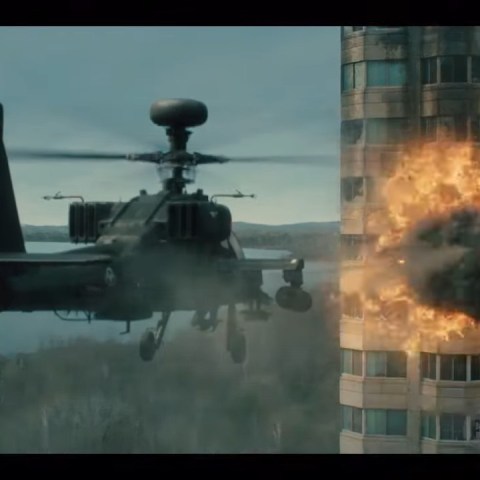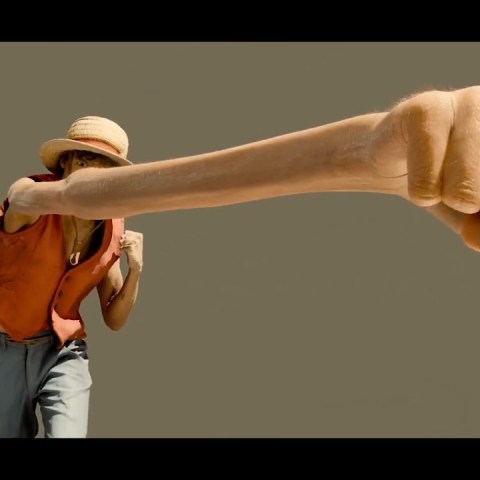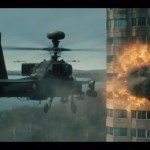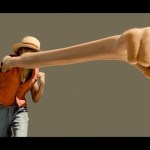From Paddington to Pooh.
Framestore sure knows how to make bears. The VFX studio has realized the creatures for several projects, including two Paddington films and two incarnations of the His Dark Materials franchise. Plus they’ve crafted the furry animals for Christopher Robin and Timmy Failure: Mistakes Were Made.
Which makes Framestore’s bears a perfect candidate for befores & afters’ latest ‘Body of Work’ breakdown. Sadly, despite the fact that some of his Guardians of the Galaxy companions call him a ‘Build-A-Bear’ and a ‘trash panda’, this piece does not include Framestore’s work on Rocket Raccoon. It does include, however, an exclusive VFX breakdown video for Timmy Failure; read on below to check it out.
The Golden Compass – lorek
Neil Weatherley, lead TD (now CG supervisor on His Dark Materials)

The Golden Compass was made when there hadn’t been that many full-CG ‘hero’ characters in a film, so it was a fair challenge even before taking into account the technical limitations of the time. We didn’t have a fully-unified pipeline at the time, so each show involved writing our own variations on a theme tailored for the work involved. So, for Compass that meant writing our own shaders for fur and snow pretty much from scratch, as well as systems to do things that are so simple now like fur colliding with bear armour and footprints in the snow.
For example, to do the armour colliding with the fur on the bears we calculated the occlusion from the armour onto the body then used those maps to alter the orientation of the fur to fake the armour pushing it down. Footprints in the snow were achieved in a similar way, using displacement maps generated before rendering the final frames. Even generating occlusion wasn’t straightforward, however, as we were having to write out point clouds with the occlusion values in which were then read back to do the shading. Again, all of the steps to do this were pretty much custom-written by the team on the show.

The bear fight between Iorek and Iofur was a big sequence for us, involving multiple background bears as well as the two hero bears and a full CG ice and snow background. It was prevized in a very non-CG way with a ‘lipstick camera’ and various cardboard cutouts of sets and bears. Our animation leads then choreographed the fight in that way.
It’s also worth mentioning that we worked on this film before the teams were quite so specialized, which meant a lot of people were doing multiple jobs – as one of the lead TDs I was writing the pipeline, writing shaders as well as more traditional lighting shots. This was the case for most of the TDs who were picking up whatever needed doing, so it meant there were a lot of generalists and everyone ‘mucking in’ which was pretty common in those days. I remember finishing entire sequences with one animator, one comp’er and one TD doing pretty much everything in between!
Paddington and Paddington 2 – Paddington
Pablo Grillo, animation supervisor

The design of Paddington was one of the most exciting challenges of the two films. At the time of Paddington’s development, a lot of the talking animals that had populated “hybrid” films had relied heavily on cartoon design conventions – either to honour original character designs from which they were being adapted or to reinforce their characterful qualities over naturalism. They were often cartoon designs dimensionalized to fit a live-action world.
For Paul King (director) and David Heyman (producer) it was necessary that Paddington felt as realistic as possible. Paddington’s world had to be a believable London being visited by a genuine immigrant bear. A crucial design decision on their part was to heighten London just enough for the conceit, so the audience believed that people of that world would accept a bear wandering around the city like any other person.
While Paddington had to feel like a real bear equipped with all the detail of the natural world, he also had to be at ease with human behaviour so that his animalism would not interfere with his ability to express himself like a person. He had to have relatable emotions and interact comfortably with the rest of the cast.

His physicality needed to be predominantly bipedal and his eyes emotionally engaging. As well as solving these issues, Paddington’s new design had to embody the spirit of an existing and much loved creation that had been rendered in many different styles.
Anyone who had grown up with this bear instinctively “knew” how Paddington ought to feel. The effortless charm and appeal of previous Paddington Bears was often described by dots for eyes, a wonky smile and a charmingly oversized hat. This simple gesture was in conflict with all the detailed realism we were now trying to give him to work in the live action space. We were looking for a nuanced graphic style that hadn’t yet been seen, a form of characterful hyper-realism wrapped around underlying simplicity and charm. We approached the problem from a number of angles.
His physicality was developed by building rough body shapes, rigging them and putting them through poses and motion studies to establish the necessary dimensions and proportions that would successfully execute the range of motion necessary to convey his character. Paddington-esque poses were inspired by Chaplin, Peter Sellers, Alec Guinness and Jaque Tati. We would get him to walk beside live action people to establish suitable height and a leg length that would help him keep up. We would then disguise his longer legs body shape with fur – this way we discovered a hybrid anatomy that would look bear-like but move in a more human way. Finding the look of his face was a lengthy journey involving sketches, sculptures and paint-overs.

Simple pencil sketches often carried the most character and energy but seldom helped us solve the problem of how to make him photoreal. We explored facial shapes and proportions with sculpts and often moved to simple grooms when we felt we had landed on something good. These rudimentary renders would give us really good foundations for creating paint overs which carried a sense of real world lighting and fur.
The tricky thing was finding a simple and elegant shape to the face with plenty of personality and appeal, whilst applying just enough real bear detail so as to not interfere with the quick facial read. We were looking for something that captured the essence of those charming, simple drawings whilst sitting believably in the live-action world.
Certain bear-like characteristics were thrown out in favour of more naive and appealing forms. The typically bear-like, bridge of the nose and heavy muzzle of the bear seemed to interfere with his youth. Instead his tear-dropped muzzle shape was derived from the red-panda, which has a sweeter face shape and draws more focus onto the eyes. His eyes were designed to feel “dot-like” at a distance. The whites of the eyes were kept to a minimum in order to avoid the obvious, cartoon-like expressions.
The economy of his face and expressions dignifies him and at times lends him the inscrutability of the silent comedian. His performances often rely on delicately timed for thought beats followed by physical actions that reveal his intent rather than heavy facial gesticulation. We looked closely at Chaplin here.
When closing in on his eyes during more emotional moments we made sure there was enough warmth, detail and depth that could convey nuanced emotion and conflict.
The hunt for Paddington was a long one with twists and turns, sometimes unsettling and causing a sleepless night or two, but when we caught the first glimpse of that bear that could be him we all knew it was right.
Paddington 2 – Paddington
Claire Michaud, lighting supervisor
When I started working on Paddington 2, the first challenge we faced in the lookdev team was to “rebuild” the bear of the first film, Paddington, but with the latest shaders and technologies we had at that time at Framestore. We needed to make him look better but also the same as before, which can be very tough, especially when your reference is an old CG render! You also have to convince the clients that the changes are for the best.
Another challenge was the amount of shots and different environments and the multitude of Paddington costumes and accessories. We had to build a lot of assets that Paddington interacts with. Most of them are not even rendered CG but are just there to cast and bounce lighting accurately onto him.
One of my favorite sequences is when Paddington wanders into a gigantic pop-up book of London. I really enjoyed trying to find the scale and look of the paper assets, and the translucency of them. It was quite difficult to find the right balance for it, to still make it feel like paper when you see it from so close. It is also quite rare in VFX to work on an “arty” sequence, I found it very refreshing and unique!
Christopher Robin – Winnie the Pooh
Theo Jones, VFX supervisor

From our first conversations with director Marc Forster it was clear his vision for the movie hinged on maintaining a feel of complete realism throughout – he needed the audience to believe, as Christopher Robin does, that these are his childhood toys come to life. We therefore knew that we had to push the quality of our character builds to new heights.
In building these characters we worked incredibly closely with the team making the on-set stand-in ‘stuffies’. These practical stuffies provided both the best possible reference and the most exacting benchmark in creating our digital versions of the characters. We utilized the sewing patterns supplied by the practical build team to ensure that our models topology and UV’s correlated precisely to these patterns, often making novel use of cloth simulations as part of the character modelling process to ensure that the characters surfaces bulged, pinched and folded in the correct areas.

We also studied extensively the way the toys moved and the way the stuffing and fabric shifted after days and weeks of handling on set, gathering in certain areas and weakening in others. We recorded long takes of the practical stuffies being puppeteered, the motion of which our animators then matched precisely, giving us the perfect benchmark to test our builds against. All of these observations were incorporated into simulation rigs that mimicked the multiple layers of stuffing and fabric, much as our traditional creature rigs mimic layers of muscle and fat. In designing simulation rigs, the stuffing layer inside provided the driving articulation while allowing the exterior fabric freedom to slide, fold and pinch gave the toys the feeling of tactile realism that Marc was after.
We realized early in the character build process that our current fur simulation software was not going to give us the speed, stability and control that was required for so many close up shots of fine fur interacting with highly complex geometry such as Pooh’s jumper. Our R&D team therefore embarked on developing new software that allowed us to solve complex dynamic fur movements in minimal simulation iterations and gave stable results even when calculating hundreds of thousands of hair to hair collisions or colliding with very high detail geometry. This software proved invaluable in achieving subtle, high quality fur simulations for multiple characters across hundreds of
shots.
We always wanted our characters to feel embedded in their environment, so interaction was key. We spent considerable time studying the way the practical stuffies’ fur moved in the wind, stuck to honey or clumped when wet. We then mimicked this faithfully in our simulations, even matching individual gusts of wind to the plate photography.
His Dark Materials – lorek
Zhenggang Deng, rigging technical director

I consider myself very lucky to have worked on His Dark Materials, especially on a character like Iorek, which is a rare gift. The biggest challenge for me was to realistically convey Iorek’s highly dynamic performance, especially when it came to close-up facial shots.
For this, we relied on our in-house muscle system which allowed us more time to focus on the details and quality of the deformation, and work closely with the modelling and FX teams to provide animators with a fast, intuitive rig with full body muscle, bone, skin, tension shapes and flesh simulation to preserve his volume throughout the performance. In addition, we also worked with our groom team to showcase the character’s fur and texture.

A talking polar bear is challenging. Framestore recently developed a new FACS system for realistic facial performance, and we spent a lot of time on Iorek’s face. The work involved focusing on the bear’s expressions by using video and photo references to find the correct shapes, coupled with flesh simulation to give the animation team the ability to produce subtle expressions; from realistic snarls to complex wrinkles.
We also developed a specific task to procedurally attach and animate rigid and soft parts of the bear’s armor. More specifically, it generates animation controls allowing animators to not have to tweak as much. My favourite scene? Definitely the bear fight. The fight goes by quickly, but if you break it down, there is so much work in there. It’s simply amazing.
His Dark Materials – lorek
Wayne Kresil, lead modeller
One of the most difficult things working on a character like Iorek is designing something that not only fits into the world we’re building, but also takes into consideration the pre-conceptions fans may have from reading the books. From getting his anatomy totally correct so the movement translated into the animation, through the muscles and the groom working in tandem with the armour that he wore. It was truly a team effort to bring him to the screen in such an emphatic way.
The armour proved troublesome in many ways. From getting a design that would look fantastical to a metal that does not exist in our world, and hoping to translate that into a work of art the audience was seeing from their imagination to the screen for the first time. The plates for his armour had to be designed in such a way that they could overlap, slide under each other, look like they protected him but also allow him to move, run, walk and fight. This caused us more headaches than we initially thought.
The shot that I really love is Iorek’s reveal. He comes out from the Church after he has just been reunited with his lost armour. You get the slight intro as his foot pads into screen, then a full shot of him and his armour as he stands proud. Everything about Iorek in that scene from my point of view is something we can be proud of. A true team effort to bring this loved character to the audience and onto their big screens.
Technology has progressed so much that we can create quality visual effects for TV, to the level of Film, and nothing was held back on Iorek. Every facet of bringing him to the screen involved hard work from each department, and we did our best to make him look as impressive as he was. We did so by being in close contact with our team, collaborating on how to make this happen and then getting sign off to do it the way we felt was best. It was an amazing project to work on and it’s the team that helped pull this together.
Timmy Failure: Mistakes Were Made – Total
Sophie Burie, creature FX technical director


Bringing to life the friendship between a boy and his 1,500 pound polar bear is what Timmy Failure: Mistakes Were Made was all about. The first challenge had been to create Total, Timmy’s polar bear, as photorealistic as possible, following the real-life likelihood of a Canadian polar bear named Inukshuk. Our goal became successful when we had to wonder which bear was real when put side-to-side.
Then came the otherwise challenging task of recreating the bear’s on-screen presence and his unique bond with an 11 year-old boy. The relationship between the two protagonists is marked by Total’s aloof personality, his lost glances and memorable humorous actions. To showcase the bear’s delicate performance, we had to be very minutious on a technical level. On top of simulating body muscles and fat, which ensured properly delivering the weight and jiggly stride of our character, we also added a facial expression system driven by Animation and dynamically enhanced in CreatureFX, so as to simulate an organic skin reaction whenever Total roared, yawned or chewed.
A crucial part of making Total believable is also seen through his interactions with Timmy. The face-to-face sequence in the aquarium (or should I say paw-to-hand) is an iconic scene in the movie, as well as the emotional hug in front of the zoo, when Timmy believes he has to part with his friend. For this specific shot, we pushed the boundaries of our in-house fur solver to realize a seamless interaction between the actor’s hand and our CG fur, working closely with Compositing for the integration. With each iteration, a lot of attention was brought in breaking the fur clumps which were interacting with the actor’s fingers, and achieving a realistic grab-and-release effect. The contact was instrumental in conveying the emotions of our characters in this very special, wordless moment. We didn’t stop until we knew we had effectively done so.


















